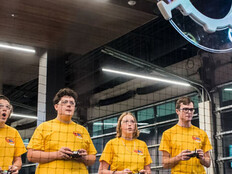K–12 Schools Should Teach Soft Skills to Prepare Students for the Future Workforce
While digital tools are woven into educational pedagogy nationwide, another component of learning may help educators give students advantages in a world not yet known to them.
A 2017 Report by Dell Technologies estimates that 85 percent of the jobs that will exist in 2030 — fewer than 12 years from now — haven’t been invented yet.
“The pace of change will be so rapid that people will learn ‘in the moment,’ using new technologies such as augmented reality and virtual reality. The ability to gain new knowledge will be more valuable than the knowledge itself,” Dell Technologies said in a statement announcing the report.
While rapidly advancing technologies should be introduced to schools, students’ social and emotional learning should also be nurtured. These soft skills will help them best navigate their new world and adapt as exciting new jobs are created.
SEL Needed to Succeed in Future Employment
Today, social and emotional learning tools are in high demand, with employers seeking people who have not only professional and technical skills, but also the ability to collaborate and work with a team, critical thinking capabilities, professionalism and effective communication talents.
According to the Collaborative for Academic, Social and Emotional Learning, SEL can be defined as “the process through which children and adults acquire and effectively apply the knowledge, attitudes and skills necessary to understand and manage emotions, set and achieve positive goals, feel and show empathy for others, establish and maintain positive relationships, and make responsible decisions.”
School administrators, too, will see the benefits of SEL instruction — not just in a healthier student body, but in a return on investment of $11 for every dollar spent on SEL instruction, according to a cost-benefit analysis conducted at the Center for Benefit-Cost Studies in Education, Teachers College, Columbia University.
Students moving on to college or the workforce need soft skills in order to succeed and make it through the talent pipeline, and businesses that will employ these students expect them to come equipped with a range of skills. So, how do we make that happen?
SEL in the Classroom Through Digital Integration
While we expect parents and other caregivers to instill some of these soft skills, schools also have a role to play in advancing students’ personal attributes to help them succeed. Because SEL is currently emerging, it can be difficult to implement, track and measure. That shouldn’t stop IT administrators and educators from trying. A good first step would be to test SEL functions through digital tools such as game-based learning and wearable devices.
Smart watches can track a student’s physiological indications of stress, and help them with other SEL competencies including relationship skills, self-awareness, critical thinking, self-management and responsible decision-making.
Audio systems that include microphones can help with public speaking, which can hone a student’s ability to listen, bolster their confidence and give them a voice.
Google Classroom is an engaging and useful collaborative tool. It is the gateway to G-Suite for Education, which was built to promote collaboration and communication in the classroom. Students can use the platform to work together digitally on a project — a skill that employers will welcome. Google Classroom also gives teachers the ability to provide timely feedback, which improves the quality of student work.
While technology is shaping the way in which we work now and in the future, SEL will help students grow and learn socially, emotionally and behaviorally. Everyone will reap the rewards.
![[title]Connect IT: Bridging the Gap Between Education and Technology [title]Connect IT: Bridging the Gap Between Education and Technology](http://www.edtechmagazine.com/k12/sites/default/files/articles/2014/05/connectit.jpg)









